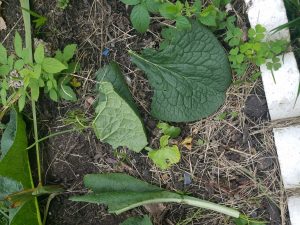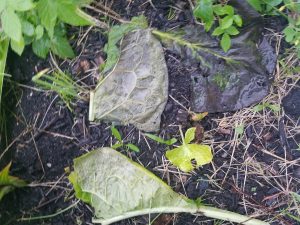Mulch and soil covers are critical for maintaining soil moisture and protecting against erosion.
With climate change bringing stronger storms, more concentrated rain events, and longer periods of heat and drought, systems that protect and rebuild soils will prove to be invaluable in maintaining stability.
While many traditional gardeners and landscapers will use things like wood chips or straw for mulch (many who even call themselves “organic” gardeners will even use woven fabrics made out of plastic!), these mulches serve serve very few functions and require routine inputs of external materials. The Southside Permaculture Park, however, employs and integrated mulching strategy that serve multiple functions and regrows itself over time.
The “Chop-n-Drop Living Mulch” incorporates multiple species of plants that work together to regulate moisture in the soil, lock in soils to mitigate erosion, fertilize the soil with nitrogen and other nutrients, attract beneficial insects and other organisms, and provide food and medicine to those that interact with it.
Probably the largest of all the living mulch elements, Comfrey provides abundant biomass rich in mineral nutrients from deep in the soil. The large leaves can be cut back as frequently as every 3 weeks in the peak of summer and placed full over any unwanted plants or ripped up and scattered around. Comfrey is also medicinal, and the flowers attract beneficial insects.

While comfrey accumulates many nutrients, it cannot fix its own nitrogen, and so it must be paired with nitrogen fixers like clover, vetch, and/or alfalfa do ensure that the soils have sufficient nitrogen for he the keystone species that are being mulched around. In addition to providing nitrogen, these plants provide food and medicine while attracting beneficial insects.
Other important living mulch elements include edible violets, medicinal and edible plantain leaf, and low-crawling edible flowers like the pest-distracting nasturtium [59]. Turkish rocket is another great nutrient accumulator, and the foliage can be chopped and dropped after harvesting the edible stalk and florets.
All of these plants prevent direct sun and wind from drying out the soil while also reducing the impact energy of heavy rain and wind. The pervasive root system, absent in “dead mulch”, acts as a binding web that holds the soil together and prevents it from being washed away by wind and rain.
In permaculture, every element supports multiple functions and every important function is supported by multiple elements.
This living mulch not only maintains soil moisture and prevents erosion, but also provides food and medicine, attracts beneficial insects, and fertilizes the soil! And even if any one element where to fail, for example if the rabbits killed all the violets, the whole system would still be stable and productive because of the redundancy built into its structure.

Living mulches area great way to get additional yields out of the scarce garden space in urban environments, while also protecting and regenerating precious soils, and providing additional layers of protection against climate change. By filling all these niches with the living mulch, we make it much less likely that undesirable plants will find there way in, and even if they do, it just means we need to observe it and see what resource streams it is taking advantage of and how we can utilize those streams as well! Plus, they look beautiful!